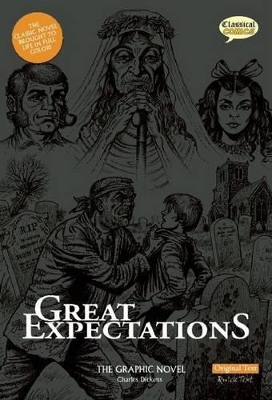
Wuthering Heights The Graphic Novel: Original Text
School year: Year 7, Year 8, Year 9
No. of pages 160
Published: 2012
Add this book to your 'I want to read' list!
By clicking here you can add this book to your favourites list. If it is in your School Library it will show up on your account page in colour and you'll be able to download it from there. If it isn't in your school library it will still show up but in grey - that will tell us that maybe it is a book we should add to your school library, and will also remind you to read it if you find it somewhere else!
"Wuthering Heights" tells the tumultuous and passionate tale of Heathcliff and Catherine Earnshaw, whose deep love is marred by social class and revenge. After being adopted by the Earnshaw family, Heathcliff develops an intense bond with Catherine, but when she marries Edgar Linton, Heathcliff descends into bitterness. His quest for revenge wreaks havoc on the lives of those around him, leading to a cycle of suffering that impacts generations. Set against the backdrop of the Yorkshire moors, this gothic novel explores themes of love, isolation, and the destructive power of obsession. [Generated by language model - please report any problems].
This book is part of a book series called Classical Comics .
This book is aimed at children at US 6th grade+.
This book has been graded for interest at 12-17 years.
There are 160 pages in this book. This book was published in 2012 by Classical Comics .
Emily Bronte (1818-48) is perhaps best known for her one, strikingly innovative novel but was also a gifted and intense poet. Charlotte BrontA" was born on 21st April 1816, at 74 Market Street in the village of Thornton near Bradford, Yorkshire. She was one of six children born to Maria Branwell and Patrick BrontA": Maria (1814), Elizabeth (1815), Charlotte (1816), Patrick Branwell (who was known as Branwell, 1817), Emily (1818) and Anne (1820). Her father, Patrick, was an Irish Anglican clergyman and writer, born in County Down, Ireland, in 1777. His surname was originally Brunty, but he decided to change his name, probably to give the impression of a more well-to-do background, giving the world the now familiar BrontA". A" Charlotte's mother, Maria, was born in 1785, to a prosperous merchant family in Cornwall. Patrick and Maria met in Hartshead, Yorkshire, while she was helping her aunt with the domestic side of running a school. In April 1820, when Charlotte was four years old, the family moved a short distance from Thornton to Haworth, where Patrick had been appointed perpetual curate of the church. Maria's sister, Elizabeth joined them a year later to help look after the children and to care for her sister, who was suffering from the final stages of cancer. She died in September 1821 - Charlotte was still only five years old. The Parsonage at Haworth was a literary household. From early childhood, the BrontA" children had written about the lives, wars and sufferings of people who lived in their own imaginary kingdoms. The story goes that Branwell had been given a set of toy soldiers in June 1826, and from these the children developed imaginary worlds of their own. Charlotte and Branwell wrote stories about their country - AngriaA" - and Emily and Anne wrote articles and poems about theirs - GondalA". These sagas, plays, poems and stories were written down in handmade little booksA" - books that they made from paper sheets stitched together. In a letter to author and biographer Elizabeth Gaskell, In July 1824 Maria (ten) and Elizabeth (nine) were sent to the Clergy Daughter's School at Cowan Bridge, near Kirkby Lonsdale in Lancashire. Charlotte (eight) and Emily (six) joined them there in August. Life at boarding school must have been grim. Maria became ill and was sent home in February 1825; she died at Haworth in May. Elizabeth fell ill that same month and, like her sister, was sent home; she died just a few months later. Both sisters died of tuberculosis (also known as consumptionA") and as a result of their deaths, Emily and Charlotte were withdrawn from the school. These events obviously had a great impact on Charlotte, who drew on the experience for Jane Eyre when she described Lowood School and the death of Helen Burns. In fact much of the novel mirrors Charlotte's own life. Charlotte, like Jane, spent many years as a governess for a number of families - a career which she viewed with some distaste (a view which appears in Chapter 30 of this book, at the bottom of page 95). Having no personal fortune and few respectable ways of earning a living, this was the only socially acceptable option for many genteel young ladies. Emily and Anne also became governesses, although Emily's career as a teacher was short-lived; it is reported that she told her pupils at Miss Patchett's School in Halifax that she much preferred the school dog to any of them!
This book is in the following series:



